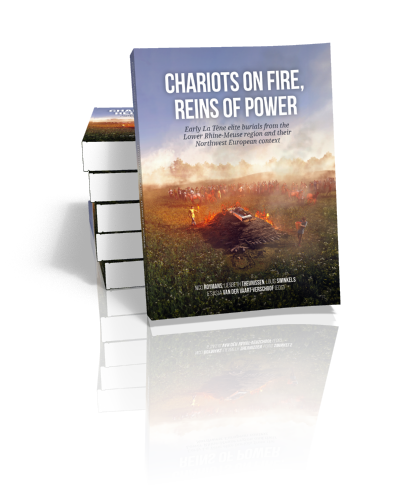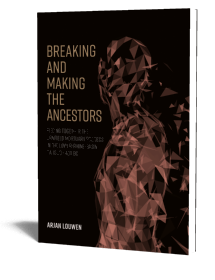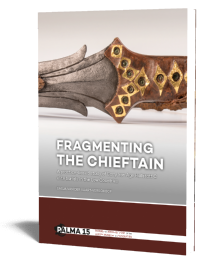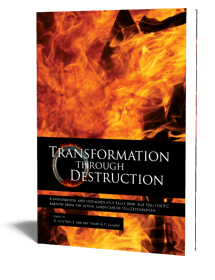Chariots on fire, reins of power
Early La Tène elite burials from the Lower Rhine-Meuse region and their Northwest European context
Edited by Nico Roymans, Liesbeth Theunissen, Louis Swinkels & Sasja van der Vaart-Verschoof | 2024

Chariots on fire, reins of power
Early La Tène elite burials from the Lower Rhine-Meuse region and their Northwest European context
Edited by Nico Roymans, Liesbeth Theunissen, Louis Swinkels & Sasja van der Vaart-Verschoof | 2024
Paperback ISBN: 9789464262940 | Hardback ISBN: 9789464262957 | Imprint: Sidestone Press | Format: 210x280mm | 546 pp. | Language: English | 77 illus. (bw) | 235 illus. (fc) | Keywords: funerary archaeology; Iron Age; elite burials; chariots; interregional connectivity; Early La Tène period; Lower Rhine-Meuse region; human mobility; social change | download cover | DOI: 10.59641/a9d5x6y7z8
Read online 443 times
- Digital & Online access
-
Buy via Sidestone (EU & UK)
-
Buy via our Distributors (WORLD)
For non-EU or UK destinations you can buy our books via our international distributors. Although prices may vary this will ensure speedy delivery and reduction in shipping costs or import tax. But you can also order with us directly via the module above.
UK international distributor
USA international distributor
-
Bookinfo
Paperback ISBN: 9789464262940 | Hardback ISBN: 9789464262957 | Imprint: Sidestone Press | Format: 210x280mm | 546 pp. | Language: English | 77 illus. (bw) | 235 illus. (fc) | Keywords: funerary archaeology; Iron Age; elite burials; chariots; interregional connectivity; Early La Tène period; Lower Rhine-Meuse region; human mobility; social change | download cover | DOI: 10.59641/a9d5x6y7z8
Read online 443 times

We will plant a tree for each order containing a paperback or hardback book via OneTreePlanted.org.
Chariots on Fire, Reins of Power presents the first comprehensive overview of 5th century BC elite graves from the Lower Rhine-Meuse region. Characterised by imported grave goods such as bronze vessels, horse tack, weapons and occasionally two-wheeled vehicles, these strikingly rich cremation burials are the northernmost representatives of an elite culture that had its roots in the Late Hallstatt and Early La Tène culture of more southern regions in France and the German Rhineland.
This book is the result of an interdisciplinary study of this northern group of graves, prompted by the recent discovery of a new chariot burial at Heumen, the Netherlands. It will be of great interest to anyone interested in the material culture of the Iron Age and the wider debate about social transformations in the European region at this time. All elite graves in the area were reexamined from a practice perspective, including the examination of all grave goods using a wide range of techniques, including examination of use-wear traces and XRF-analysis. Physical anthropological study of cremated remains revealed new insights into the ages and sex of the elite dead, and strontium analysis provided valuable insights into Middle Iron Age mobility. Technical study from a practical equestrian perspective revealed the presence of both chariots with accompanying draught horses, as well as riding horses that wore elaborately decorated tack.
The 5th century BC reveals itself as a highly dynamic period in the study area, with the appearance of elite graves being just one element in the broad spectrum of social changes that occurred during this phase. The urnfields fell into widespread disuse, small new cemeteries with flat graves emerged, a practice of inhumation was introduced in the Dutch river area, and ‘Marne ceramics’, a new pottery style, spread rapidly. In order to understand these complex regional dynamics, this book proposes a model that allows scope for intensive interregional connectivity, demographic fluctuations and probably also the small-scale immigration of southern groups, not just elites but lower social groups as well.
Preface
1 Introduction. Early La Tène elite burials from the Lower Rhine-Meuse region
Nico Roymans, Liesbeth Theunissen & Sasja van der Vaart-Verschoof
PART I. PRESENTING EARLY LA TÈNE ELITE BURIALS FROM THE LOWER RHINE-MEUSE REGION
2 The Heumen elite burial. A newly discovered grave of a chariot driver and horse rider
Nico Roymans, Tess Doorewaard, Niels Stoffels, Liesbeth Theunissen & Sasja van der Vaart-Verschoof
3 The Overasselt situla grave
Louis Swinkels & Sasja van der Vaart-Verschoof
4 A lady with her chariot? The Nijmegen-Traianusplein cemetery and vehicle burial
Sasja van der Vaart-Verschoof, Tess Doorewaard, Ineke Joosten & Art Proaño Gaibor
5 The elite graves of Wijshagen-De Rieten on the Kempen Plateau
Guido Creemers, Luc Van Impe, Guy De Mulder, Erwin Meylemans, Niels Stoffels, Nico Roymans & Sasja van der Vaart-Verschoof
6 The Eigenbilzen elite burial(s)
Guido Creemers, Luc Van Impe, Eugène Warmenbol & Nico Roymans
7 Other conspicuous grave finds from the Lower Rhine-Meuse region
Nico Roymans, Louis Swinkels & Sasja van der Vaart-Verschoof
PART II. SCIENCE-BASED MATERIAL ANALYSES
8 Bioarchaeological study of cremated remains from three cemeteries in the Nijmegen region
Birgit Berk & Martijn van Haasteren
9 Bioarchaeological analyses of the cremated remains from the Iron Age elite graves of Wijshagen-De Rieten
Barbara Veselka, Ben Gruwier, Rica Annaert, Mathieu Boudin, Giacomo Capuzzo, Sarah Dalle, Guy De Mulder, Marta Hlad, Charlotte Sabaux, Kevin Salesse, Amanda Sengeløv, Elisavet Stamataki, Martine Vercauteren, Eugène Warmenbol & Christophe Snoeck
10 Comparative science-based analyses of bronze grave goods
Liesbeth Theunissen, Bertil van Os, Louis Swinkels, Luc Megens, Lambert van Eijck & Ineke Joosten
11 Tracing Marnian pottery imports through XRF-analysis
Bertil van Os, Ineke Joosten & Peter van den Broeke
PART III. COMPARATIVE ANALYSES AND SOCIAL INTERPRETATIONS
12 Changing pottery style and the diffusion of Marnian ware
Peter van den Broeke
13 Early La Tène two-wheeled vehicles and horse tack in the Lower Rhine-Meuse region. A technical and practical equestrian perspective
Tess Doorewaard & Sasja van der Vaart-Verschoof
14 Characterising Early La Tène elite graves from the Lower Rhine-Meuse region and their interregional connections
Nico Roymans
15 Societal change and interregional connectivity in the 5th-century BC Lower Rhine-Meuse region
Nico Roymans, Lasse van den Dikkenberg & Lisette M. Kootker
PART IV. CONCLUSION
16 Final remarks. New insights and the Lower Rhine-Meuse region from a European perspective
Nico Roymans
Samenvatting / Zusammenfassung / Resumé / Summary
List of contributors
Prof. (em.) dr. Nico Roymans
Nico Roymans is Emeritus Professor of West-European Archaeology at the Vrije Universiteit Amsterdam. His research focuses on Iron Age and Roman societies, with a special interest in the study of social identities, conflict archaeology, landscape archaeology, and Iron Age material culture. He has directed many large, externally funded research projects.
Drs. Louis Swinkels
Louis Swinkels was curator of archaeology at the Valkhof Museum in Nijmegen. His research interests lie primarily in the fields of Roman iconography and epigraphy, museum studies and the history of archaeology.

Dr. Sasja van der Vaart-Verschoof
Sasja van der Vaart-Verschoof is a freelance consultant, researcher and editor known as the Overdressed Archeologist & Editor. In addition to publishing half a dozen books with us, she frequently collaborates with Sidestone Press doing both copy editing, book design and our social media marketing.
Abstract:
Chariots on Fire, Reins of Power presents the first comprehensive overview of 5th century BC elite graves from the Lower Rhine-Meuse region. Characterised by imported grave goods such as bronze vessels, horse tack, weapons and occasionally two-wheeled vehicles, these strikingly rich cremation burials are the northernmost representatives of an elite culture that had its roots in the Late Hallstatt and Early La Tène culture of more southern regions in France and the German Rhineland.
This book is the result of an interdisciplinary study of this northern group of graves, prompted by the recent discovery of a new chariot burial at Heumen, the Netherlands. It will be of great interest to anyone interested in the material culture of the Iron Age and the wider debate about social transformations in the European region at this time. All elite graves in the area were reexamined from a practice perspective, including the examination of all grave goods using a wide range of techniques, including examination of use-wear traces and XRF-analysis. Physical anthropological study of cremated remains revealed new insights into the ages and sex of the elite dead, and strontium analysis provided valuable insights into Middle Iron Age mobility. Technical study from a practical equestrian perspective revealed the presence of both chariots with accompanying draught horses, as well as riding horses that wore elaborately decorated tack.
The 5th century BC reveals itself as a highly dynamic period in the study area, with the appearance of elite graves being just one element in the broad spectrum of social changes that occurred during this phase. The urnfields fell into widespread disuse, small new cemeteries with flat graves emerged, a practice of inhumation was introduced in the Dutch river area, and ‘Marne ceramics’, a new pottery style, spread rapidly. In order to understand these complex regional dynamics, this book proposes a model that allows scope for intensive interregional connectivity, demographic fluctuations and probably also the small-scale immigration of southern groups, not just elites but lower social groups as well.
Contents
Preface
1 Introduction. Early La Tène elite burials from the Lower Rhine-Meuse region
Nico Roymans, Liesbeth Theunissen & Sasja van der Vaart-Verschoof
PART I. PRESENTING EARLY LA TÈNE ELITE BURIALS FROM THE LOWER RHINE-MEUSE REGION
2 The Heumen elite burial. A newly discovered grave of a chariot driver and horse rider
Nico Roymans, Tess Doorewaard, Niels Stoffels, Liesbeth Theunissen & Sasja van der Vaart-Verschoof
3 The Overasselt situla grave
Louis Swinkels & Sasja van der Vaart-Verschoof
4 A lady with her chariot? The Nijmegen-Traianusplein cemetery and vehicle burial
Sasja van der Vaart-Verschoof, Tess Doorewaard, Ineke Joosten & Art Proaño Gaibor
5 The elite graves of Wijshagen-De Rieten on the Kempen Plateau
Guido Creemers, Luc Van Impe, Guy De Mulder, Erwin Meylemans, Niels Stoffels, Nico Roymans & Sasja van der Vaart-Verschoof
6 The Eigenbilzen elite burial(s)
Guido Creemers, Luc Van Impe, Eugène Warmenbol & Nico Roymans
7 Other conspicuous grave finds from the Lower Rhine-Meuse region
Nico Roymans, Louis Swinkels & Sasja van der Vaart-Verschoof
PART II. SCIENCE-BASED MATERIAL ANALYSES
8 Bioarchaeological study of cremated remains from three cemeteries in the Nijmegen region
Birgit Berk & Martijn van Haasteren
9 Bioarchaeological analyses of the cremated remains from the Iron Age elite graves of Wijshagen-De Rieten
Barbara Veselka, Ben Gruwier, Rica Annaert, Mathieu Boudin, Giacomo Capuzzo, Sarah Dalle, Guy De Mulder, Marta Hlad, Charlotte Sabaux, Kevin Salesse, Amanda Sengeløv, Elisavet Stamataki, Martine Vercauteren, Eugène Warmenbol & Christophe Snoeck
10 Comparative science-based analyses of bronze grave goods
Liesbeth Theunissen, Bertil van Os, Louis Swinkels, Luc Megens, Lambert van Eijck & Ineke Joosten
11 Tracing Marnian pottery imports through XRF-analysis
Bertil van Os, Ineke Joosten & Peter van den Broeke
PART III. COMPARATIVE ANALYSES AND SOCIAL INTERPRETATIONS
12 Changing pottery style and the diffusion of Marnian ware
Peter van den Broeke
13 Early La Tène two-wheeled vehicles and horse tack in the Lower Rhine-Meuse region. A technical and practical equestrian perspective
Tess Doorewaard & Sasja van der Vaart-Verschoof
14 Characterising Early La Tène elite graves from the Lower Rhine-Meuse region and their interregional connections
Nico Roymans
15 Societal change and interregional connectivity in the 5th-century BC Lower Rhine-Meuse region
Nico Roymans, Lasse van den Dikkenberg & Lisette M. Kootker
PART IV. CONCLUSION
16 Final remarks. New insights and the Lower Rhine-Meuse region from a European perspective
Nico Roymans
Samenvatting / Zusammenfassung / Resumé / Summary
List of contributors
Prof. (em.) dr. Nico Roymans
Nico Roymans is Emeritus Professor of West-European Archaeology at the Vrije Universiteit Amsterdam. His research focuses on Iron Age and Roman societies, with a special interest in the study of social identities, conflict archaeology, landscape archaeology, and Iron Age material culture. He has directed many large, externally funded research projects.
Drs. Louis Swinkels
Louis Swinkels was curator of archaeology at the Valkhof Museum in Nijmegen. His research interests lie primarily in the fields of Roman iconography and epigraphy, museum studies and the history of archaeology.

Dr. Sasja van der Vaart-Verschoof
Sasja van der Vaart-Verschoof is a freelance consultant, researcher and editor known as the Overdressed Archeologist & Editor. In addition to publishing half a dozen books with us, she frequently collaborates with Sidestone Press doing both copy editing, book design and our social media marketing.
- Digital & Online access
-
Buy via Sidestone (EU & UK)
-
Buy via our Distributors (WORLD)
For non-EU or UK destinations you can buy our books via our international distributors. Although prices may vary this will ensure speedy delivery and reduction in shipping costs or import tax. But you can also order with us directly via the module above.
UK international distributor
USA international distributor
- Browse all books by subject
-
Search all books

We will plant a tree for each order containing a paperback or hardback book via OneTreePlanted.org.
You might also like:
© 2025 Sidestone Press KvK nr. 28114891 Privacy policy Sidestone Newsletter Terms and Conditions (Dutch)








